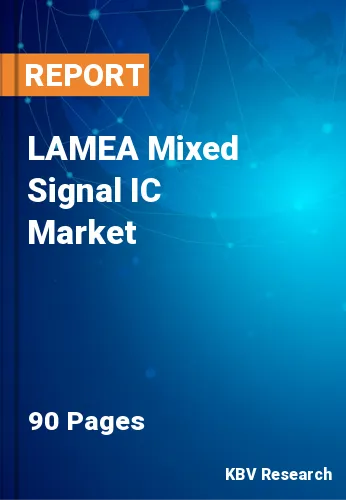Chapter 1. Market Scope & Methodology
1.1 Market Definition
1.2 Objectives
1.3 Market Scope
1.4 Segmentation
1.4.1 LAMEA Mixed Signal IC Market, by Type
1.4.2 LAMEA Mixed Signal IC Market, by End User
1.4.3 LAMEA Mixed Signal IC Market, by Country
1.5 Methodology for the research
Chapter 2. Market Overview
2.1 Introduction
2.1.1 Overview
2.1.2 Market Composition and Scenario
2.2 Key Factors Impacting the Market
2.2.1 Market Drivers
2.2.2 Market Restraints
Chapter 3. LAMEA Mixed Signal IC Market by Type
3.1 LAMEA Mixed Signal SoC Mixed Signal IC Market by Country
3.2 LAMEA Microcontroller Mixed Signal IC Market by Country
3.3 LAMEA Data Converter Mixed Signal IC Market by Country
Chapter 4. LAMEA Mixed Signal IC Market by End User
4.1 LAMEA Consumer Electronics Mixed Signal IC Market by Country
4.2 LAMEA Medical & Healthcare Mixed Signal IC Market by Country
4.3 LAMEA Telecommunication Mixed Signal IC Market by Country
4.4 LAMEA Automotive Mixed Signal IC Market by Country
4.5 LAMEA Others Mixed Signal IC Market by Country
Chapter 5. LAMEA Mixed Signal IC Market by Country
5.1 Brazil Mixed Signal IC Market
5.1.1 Brazil Mixed Signal IC Market by Type
5.1.2 Brazil Mixed Signal IC Market by End User
5.2 Argentina Mixed Signal IC Market
5.2.1 Argentina Mixed Signal IC Market by Type
5.2.2 Argentina Mixed Signal IC Market by End User
5.3 UAE Mixed Signal IC Market
5.3.1 UAE Mixed Signal IC Market by Type
5.3.2 UAE Mixed Signal IC Market by End User
5.4 Saudi Arabia Mixed Signal IC Market
5.4.1 Saudi Arabia Mixed Signal IC Market by Type
5.4.2 Saudi Arabia Mixed Signal IC Market by End User
5.5 South Africa Mixed Signal IC Market
5.5.1 South Africa Mixed Signal IC Market by Type
5.5.2 South Africa Mixed Signal IC Market by End User
5.6 Nigeria Mixed Signal IC Market
5.6.1 Nigeria Mixed Signal IC Market by Type
5.6.2 Nigeria Mixed Signal IC Market by End User
5.7 Rest of LAMEA Mixed Signal IC Market
5.7.1 Rest of LAMEA Mixed Signal IC Market by Type
5.7.2 Rest of LAMEA Mixed Signal IC Market by End User
Chapter 6. Company Profiles
6.1 Analog Devices, Inc.
6.1.1 Company Overview
6.1.2 Financial Analysis
6.1.3 Segmental and Regional Analysis
6.1.4 Research & Development Expenses
6.1.5 Recent strategies and developments:
6.1.5.1 Acquisition and Mergers:
6.1.5.2 Product Launches and Product Expansions:
6.1.5.3 Geographical Expansions:
6.1.6 SWOT Analysis
6.2 Broadcom, Inc.
6.2.1 Company Overview
6.2.1 Financial Analysis
6.2.2 Segmental and Regional Analysis
6.2.3 Research & Development Expense
6.2.4 SWOT Analysis
6.3 Infineon Technologies AG
6.3.1 Company Overview
6.3.2 Financial Analysis
6.3.3 Segmental and Regional Analysis
6.3.4 Research & Development Expense
6.3.5 SWOT Analysis
6.4 NXP Semiconductors N.V.
6.4.1 Company Overview
6.4.2 Financial Analysis
6.4.3 Regional Analysis
6.4.4 Research & Development Expense
6.4.5 SWOT Analysis
6.5 Renesas Electronics Corporation
6.5.1 Company Overview
6.5.2 Financial Analysis
6.5.3 Segmental and Regional Analysis
6.5.4 Research & Development Expense
6.5.5 Recent strategies and developments:
6.5.5.1 Acquisition and Mergers:
6.6 STMicroelectronics N.V.
6.6.1 Company Overview
6.6.2 Financial Analysis
6.6.3 Segmental and Regional Analysis
6.6.4 Research & Development Expense
6.6.5 Recent strategies and developments:
6.6.5.1 Partnerships, Collaborations, and Agreements:
6.6.6 SWOT Analysis
6.7 Texas Instruments, Inc.
6.7.1 Company Overview
6.7.2 Financial Analysis
6.7.3 Segmental and Regional Analysis
6.7.4 Research & Development Expense
6.7.5 Recent strategies and developments:
6.7.5.1 Partnerships, Collaborations, and Agreements:
6.7.6 SWOT Analysis
6.8 Intel Corporation
6.8.1 Company Overview
6.8.2 Financial Analysis
6.8.3 Segmental and Regional Analysis
6.8.4 Research & Development Expenses
6.8.5 SWOT Analysis
6.9 Telephonics Corporation (Griffon Corporation)
6.9.1 Company Overview
6.9.2 Financial Analysis
6.9.3 Segmental and Regional Analysis
6.10. Ensilica Limited
6.10.1 Company Overview

